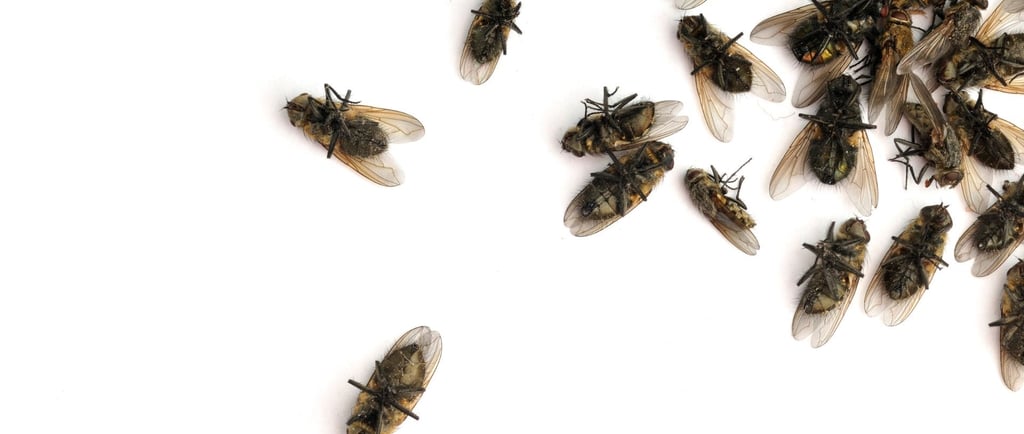Filth Flies: How to Get Rid of Them
Struggling with flies invading your home? Learn how to get rid of flies and keep your home fly-free with Pest Sensei's expert advices
Chan, H.H.


Filth flies, including house flies, flesh flies, blow flies, and bottle flies, are more than just an annoyance in homes—they are potential carriers of harmful bacteria and diseases. Unlike smaller flies that stay close to their breeding grounds, filth flies are strong fliers capable of traveling 1–3 km in search of food and suitable breeding sites. If you have a persistent fly problem in your home, the source of infestation may not always be indoors but could be coming from external breeding grounds, such as decaying animal matter.
What Causes a Fly Infestation at Home?
A fly infestation is always linked to the presence of food or a suitable breeding ground. These pests are drawn to moist, decaying organic matter such as garbage, rotten food, compost, drains, and even fallen leaves. While homeowners often maintain proper housekeeping, flies can still invade due to nearby breeding grounds.
Even if your home is spotless, nearby fly breeding sites—such as improperly sealed garbage bins, clogged drains, or animal carcasses—can attract them. Filth flies can detect food odors from miles away, which is why they seem to appear out of nowhere as soon as you start preparing a meal. They are most active during the day and tend to rest in the evening.
Why DIY Fly Control is Not Always Effective
Many homeowners attempt to control flies with DIY solutions like repellents, sprays or natural remedies, but these methods only offer temporary relief. The real challenge is identifying and eliminating the source of the infestation, which is usually beyond the house. It is usually not feasible to locate and address the breeding ground effectively, especially if it is outside the boundary of your premises.


Install Screens
If you are dealing with filth flies from external sources, installing fly screens on your windows and doors can provide quick relief. These screens act as barriers, preventing flies from entering your living spaces. Based on our survey, homeowners experience more than 95% reduction in flies after installing fly screens.


Essential Fly Prevention Tips
If you want to make your home less attractive to flies, sanitation is key. Here are some important steps:
Clear Leaf Litter Regularly: Fallen leaves and organic debris can serve as breeding grounds for flies.
Cover Garbage Bins: Ensure garbage bins have tight-fitting lids to prevent flies from accessing food waste.
Clean Garbage Bins Frequently: Flies are attracted to strong odors, so washing bins regularly helps reduce fly activity.
Cover Compost Bins: If you compost, use a cover or mesh to keep flies away.
Remove Pet Waste Promptly: Animal feces attract filth flies and serve as breeding grounds.
Wash Away Bird Droppings: Certain fly species thrive in areas with bird droppings.
Dispose of Rotten Food Immediately: Keep all food waste in sealed bins to prevent fly infestations.
Properly Handle Animal Carcasses: If you find a dead rodent or bird, dispose of it properly to avoid attracting flies.
While these preventive measures can help, they require ongoing diligence. Even the cleanest homes can still experience fly infestations due to external factors beyond their control.
The Limitations of Fly Repellents
Repellents and deodorizers can help deter flies, but they do not address the root cause of an infestation. If the breeding ground is nearby, flies will continue to return no matter how many deterrents you use.
Instead of relying solely on repellents, the best approach is a combination of sanitation, exclusion (like fly screens), and professional pest control solutions to target the infestation at its source.
If you're struggling with a fly infestation and DIY solutions aren’t working, it's time to call the experts. Pest Sensei provides reliable and effective pest control solutions in Johor Bahru. Contact us today to schedule an inspection!
FAQs About Filth Flies
How long do flies live? Adult flies typically live anywhere from one week to two months, depending on factors like temperature, food availability, and species. They tend to live longer in cooler conditions and when nutritious food sources are abundant.
How far can flies fly? Larger filth flies can travel 1–3 km in search of food and breeding grounds, whereas smaller flies tend to stay near their breeding sites. This is why preventing large flies involves sealing entry points, while preventing small flies focuses more on sanitation.
Why are flies considered dirty? Filth flies carry over 100 different germs, including those responsible for diseases like cholera, typhoid, and tuberculosis. Their bodies are covered in bristles that pick up bacteria, and their sticky footpads allow them to spread germs onto surfaces and food.
Additionally, flies regurgitate digestive fluids onto solid food to liquefy it before feeding—an unsanitary process that can lead to contamination.
Can I eat food that a fly has landed on? If a fly lands on your food for a brief moment, the risk of contamination is low. However, if flies have been present for an extended time, it’s safer to discard the food or reheat it to kill any bacteria.
Why do flies land on people? Flies are attracted to the salts and secretions on human skin. They may also be drawn to wounds or moist areas like the eyes and mouth.
Where do flies lay their eggs? Flies lay eggs in decaying organic matter such as manure, food waste, rotting carcasses, and moist debris. Some species even lay eggs in drains or wounds. Eliminating these breeding grounds is essential for effective fly control.
Pest Sensei
Expert pest control solutions for your needs in Johor Bahru and surrounding areas.
© 2025. All rights reserved.
Powered by Solbright
